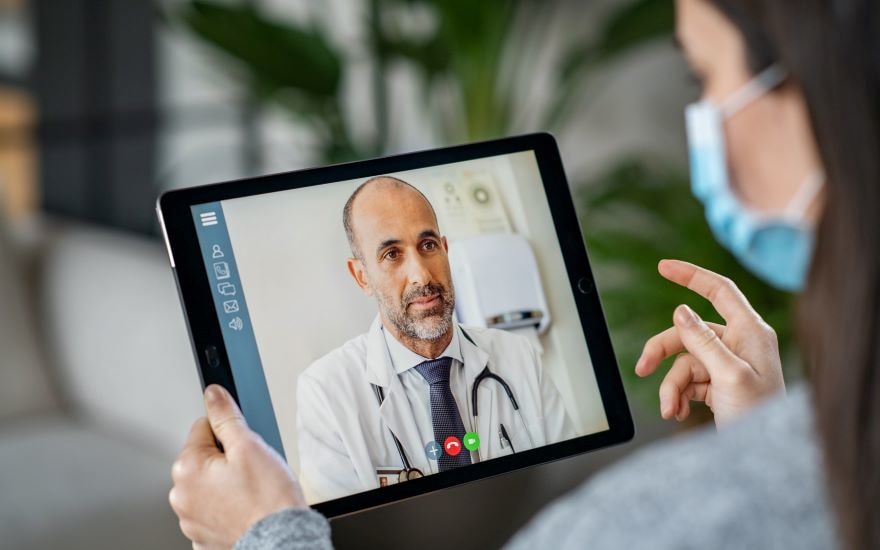How the virus turned health care on its head
Published on 17/07/2020 in Customer Stories
The corona pandemic presented our hospitals with enormous challenges for weeks. What was the impact on our health care? And how are we going to organize this in the future? AZ Groeninge’s board members share their experiences.

Medical Director Dr Serge Vanderschueren and Technology and Quality Director Sarah Boone of the AZ Groeninge in Kortrijk were on the front lines of the corona crisis. The first question is therefore obvious: how did they deal with this chaotic situation from an organizational point of view? “Of course, a hospital already has emergency plans if, for example, there is a major traffic accident or disaster,” says Serge.
“But this was quite exceptional. We decided on a Friday to shut down the hospital almost entirely by Monday and to focus completely on the coronavirus. When we communicated that to the department heads, some of them really reacted with disbelief. Nothing like this had ever happened before. Even more remarkable were the first days of the lockdown, when it was actually quite quiet and there were almost no corona cases coming in. That was surreal. It was also the quiet before the storm.”
Some remote monitoring was already being done, but it’s really breaking through now. Corona has accelerated this entire evolution.
Sarah Boone
Remote consultations and monitoring
Even though the crisis is relatively under control now and we are gradually returning to the pre-corona situation, the virus did have an impact on what medical services look like today. “Anything having to do with ‘remote’ has now been implemented quickly,” says Sarah. “Remote consultations have become the new normal for several types of appointments. Many employees have also tried working from home, and many of them have gotten a taste for it. Patients are also being monitored remotely. Some remote monitoring was already being done, but it’s really breaking through now. Corona has accelerated this whole evolution.”
“Medical group meetings of the oncology doctors, for example, are now organized remotely,” adds Serge. “That’s become the new rule. The government stimulates this as well. For example, remote consultations weren’t reimbursed in the past because a nomenclature hadn’t been provided for them. The NIHDI has now created a special nomenclature for this purpose, so that they’re actually reimbursed now.”
A digital work environment that supports employees that work from home can make a big difference to your business and the economy.
How to support teleworkingLogistical challenge
COVID-19 also left its mark on treatment methods. “We learn by doing,” says Serge. He lists the use of dexamethasone in viral infections as an example, something that was previously unknown. “Today, the drug is administered and reduces the risk of death by one third. 3D printing is now being used more and more in hospitals. Because certain parts were not available, alternatives were printed using 3D printers.”
“We notice that some departments really do benefit from fewer people and more peace and quiet. The maternity ward, for example, is typically one of those departments that benefits from fewer visits. On the other hand, we shouldn’t get carried away. Loneliness is disastrous and we know that visits can have a healing effect. So, we have to find a balance.”
At the same time, certain internal processes in the hospital are being re-evaluated. “COVID-19 certainly entailed a logistical challenge as well,” adds Sarah. “Many things needed to be delivered to the hospital in a short time frame, and much of it was disposable material. Nowadays, we are increasingly looking at reusable material that can be sterilized, allowing for some level of sustainability. For example, we are now paying more attention to emergency stocks of certain materials. This is also a result of corona.”
Hospitals will collaborate and network even more.
Dr Serge Vanderschueren
What will become the new normal for the business world?
How businesses keep workingEvolution in health care: data and networks
How will health care evolve in the future and how does the health crisis play a role here? “I don’t know if it really has to do with corona, but what I’m absolutely convinced of is that the importance of data and data analysis in hospitals is going to explode in the next few years,” says Sarah. “Everything will be measured, stored, and analyzed using artificial intelligence. There will be additional challenges: how are we going to unlock data? How are we going to share it? And of course, how are we going to secure it. Those will be great challenges.”
“I foresee two major trends in the coming years,” says Serge. “First, hospitals will collaborate and network even more. From buying supplies to receiving patients; I am in contact nearly every day with the seven hospitals with which we form a network. Second, I think that primary and secondary health care will grow closer and help each other even more. I'm thinking of general practitioners and residential care centers, for example. That was already happening, but the corona crisis accelerated it. If the pandemic has had one positive effect, it’s probably that.”
One
One magazine is the Proximus B2B magazine for CIOs and IT professionals in large and medium-sized organisations.

